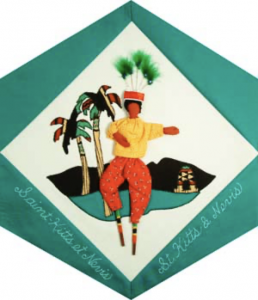Saint Kitts and Nevis

The Block
Gillian Legroulx collaborated with Viola Halley and other members of the Saint Kitts Canadian Association of Toronto to design this block. Inspired by Carnival, the nation’s largest, annual celebration, Gillian created an appliquéd version of a Moko Jumbie to take centre stage on the block. Moko Jumbies, a featured Carnival attraction, are colourfully costumed men on six- to eight-foot stilts who deftly parade their way through throngs of revelers. Elegant headpieces fixed with peacock feathers sit atop their heads, resembling the heart of the macaw plant in bloom and adding even more to their height. Macaw palm trees are known for being very tall and thorny, which is likely the reason why some people believe Moko originated from the word macaw. In the distance, behind the block’s Moko Jumbie, coconut palm trees tower over a sugar mill. Numerous oval-shaped mills still dot the landscapes of Saint Kitts and Nevis, standing as reminders of bygone days when sugar plantations were both prosperous and an essential part of island life.
Cultural Profile
The island of Saint Kitts was once known as Saint Christopher, so-called by explorer Christopher Columbus for his patron saint. Nevis he named Nieves, the Spanish word for ‘snow,’ after he mistook the constant mist atop its highest point (Nevis Peak) for the frozen precipitation. Together the two form a unitary island nation in the eastern Caribbean. The islands, once colonies of the United Kingdom, are located within the Leeward Islands and are separated by a three-km-wide channel called The Narrows. The distinctive coastline of Saint Kitts, the larger of the two islands, measuring 176.6 km, is shaped like a baseball bat and is coincidentally complemented by that of Nevis, 93.2 km2, which is shaped like a ball. The islands are a lush tropical paradise due to the rich volcanic soil produced by Saint Kitts’ now extinct volcanic peak, Mount Liamuiga. Green fertile hills and valleys contrast beautifully with white sandy beaches and vivid blue sea, providing the perfect home for green vervet monkeys, endangered brown pelicans, the national bird, and brilliantly coloured Poincianas, the national flower. More than 38,000 people live here and the official language is English.
Until the 1970s sugar was the mainstay of the islands’ economy––demand for the product once made Nevis so affluent it became known as the “Queen of the Caribbees”––and while the crop still dominates the agricultural sector, activities such as tourism, export-oriented manufacturing, and offshore banking have assumed larger roles in the economy. The Carnival, celebrated around Christmas and New Year’s Day, is an important event for locals and tourists alike. Exuberant costumes, clowns and dancing enliven the Carnival’s parades and street parties.
Throughout Saint Kitts and Nevis a great deal of value is placed on natural preservation, so much so that in the capital cities of Basseterre and Charlestown there is a law stating that no building may be taller than the surrounding palm trees. The stunning beauty of the islands serves as inspiration for its laid-back inhabitants who favour using the islands’ natural materials for their arts and crafts. They are noted for woodcarvings and unique craftwork created from coral, seashells, and coconut shells, as well as for pottery, basketry, sea-island cotton and batiks.
People have been coming to Canada from Saint Kitts and Nevis since 1946 and, like so many others from Caribbean nations, they strive to promote, maintain and share their cultural heritage through food, music, dance and song. As of 2011, there were over 2,200 Kittitians and Nevisians living in Canada.
Sponsor: Lee Family
